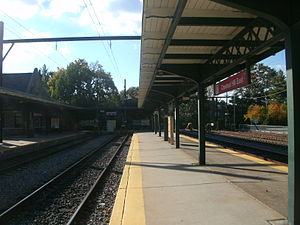Chestnut Hill East station
 The Chestnut Hill East station as seen in October 2012. The station depot, constructed by the Reading Company, is visible on the left. | |||||||||||||
| General information | |||||||||||||
| Location | 100 East Chestnut Hill Avenue, Philadelphia, Pennsylvania, U.S. | ||||||||||||
| Coordinates | 40°04′52″N 75°12′28″W / 40.0810°N 75.2079°W | ||||||||||||
| Owned by | SEPTA | ||||||||||||
| Line(s) | Chestnut Hill East Branch | ||||||||||||
| Platforms | 1 side platform, 1 island platform | ||||||||||||
| Tracks | 6 | ||||||||||||
| Connections | Chestnut Hill West station | ||||||||||||
| Construction | |||||||||||||
| Parking | 104 spaces | ||||||||||||
| Accessible | No | ||||||||||||
| Other information | |||||||||||||
| Fare zone | 2 | ||||||||||||
| History | |||||||||||||
| Opened | December 1, 1854[1] | ||||||||||||
| Rebuilt | 1931 | ||||||||||||
| Electrified | February 5, 1933[2] | ||||||||||||
| Previous names | Chestnut Hill (December 1, 1854–April 1, 1977)[1][3] | ||||||||||||
| Key dates | |||||||||||||
| June 1931 | Station depot demolished[4] | ||||||||||||
| Services | |||||||||||||
| |||||||||||||
| |||||||||||||
| |||||||||||||
Chestnut Hill East station is a SEPTA Regional Rail station in Philadelphia, Pennsylvania. Located at 102–04 Bethlehem Pike at Chestnut Hill Avenue, it serves the Chestnut Hill East Line. The current station building was built in 1931 by the Reading Railroad,[5] as a replacement for an earlier station that existed between 1872 and 1930.[6]
The station is in zone 2 on the Chestnut Hill East Line, on former Reading Railroad tracks, and is 10.8 track miles from Suburban Station. In 2013, this station saw 433 boardings and 479 alightings on an average weekday.[7] Chestnut Hill East is often confused with Chestnut Hill West, which is a SEPTA station a few minutes away from Chestnut Hill East's location. Boarding statistics, however, show greater usage of this line than of the Chestnut Hill West Line by Chestnut Hill residents.
Prior to rebuilding and electrification circa 1931, the stub terminal had three short passenger car tracks serviced by two platforms, a small engine terminal with a turntable, five-stall roundhouse and water tank, plus a few freight tracks serving storage buildings and a coal and lumber business.[8]
Bibliography
- Hosking, George (1913). Moody's Manual of Railroads and Corporation Securities: Volume I Fourteenth Annual Number 1913. New York, New York: Moody Manual Company.
References
- ^ a b Hosking 1913, p. 854.
- ^ "New Electric Schedule". The Scranton Times. February 4, 1933. p. 12. Retrieved August 21, 2020 – via Newspapers.com.

- ^ Baer, Christopher T. (April 2015). "A General Chronology of the Pennsylvania Railroad Company, Its Predecessors and Successors and Its Historical Context: 1977" (PDF). Pennsylvania Railroad Technical & Historical Society. p. 11. Retrieved January 14, 2025.
Apr. 1, 1977 – SEPTA renames ex-PRR Chestnut Hill station "Chestnut Hill West" and ex-Reading station "Chestnut Hill East."
- ^ "Reading Plans Station". The Philadelphia Inquirer. June 21, 1931. p. 16. Retrieved October 21, 2021 – via Newspapers.com.

- ^ "Chestnut Hill East station photos (Existing Stations in Philadelphia County, Pennsylvania)". Archived from the original on 2008-06-04. Retrieved 2008-08-15.
- ^ Original Chestnut Hill Reading Railroad station postcard (Existing Stations in Philadelphia County, Pennsylvania)
- ^ "SEPTA (May 2014). Fiscal Year 2015 Annual Service Plan. p. 61" (PDF). Archived from the original (PDF) on 2014-08-12. (539 KB)
- ^ Edwin P. Alexander. Model Railroads. New York, N.Y.: W.W. Norton & Co., 1950. Pp. 38, 40-41.

